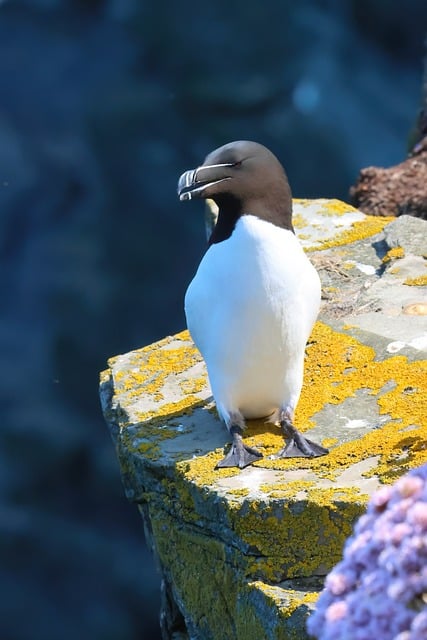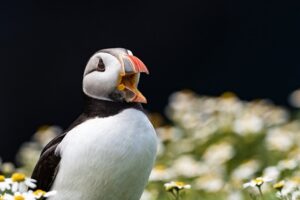Introduction
Auks, those fascinating seabirds of the North Atlantic, have captivated the hearts and minds of bird enthusiasts, historians, and conservationists alike. Auks are classified in the avian order Charadriiformes and family Alcidae. Once abundant across the icy shores of the North Atlantic, these remarkable birds, including the iconic Great Auk, have become emblematic of the fragility of our ecosystems. Thei tragic extinction of the Great Auk in the 19th century serves as a poignant reminder of the profound impact of human activity on wildlife. This narrative invites us to delve deeper into the world of auks, exploring their biology, behavior, and the ecological significance of their relatives that still inhabit our coastlines today.
The Great Auk: A Tragic Tale Of Extinction
The Great Auk (Pinguinus impennis) was the largest member of the auk family, standing approximately 75 centimeters(2’6″) tall, with a robust body, a large bill, and striking black-and-white plumage. This bird was well-adapted to their marine environment, possessing powerful wings that were used for swimming rather than flying. Great Auks were known to breed on rocky islands, forming large colonies that would come together during the breeding season.
Historically, the Great Auk was found in Canada, Norway, Greenland, Iceland, the Faroe Islands, Ireland, Great Britain, France, Italy, and the Northeastern United States, but by the mid-19th century, they had vanished from the earth. The relentless hunting for their feathers, meat, and eggs, coupled with habitat destruction, led to their rapid decline. The last confirmed sighting of a Great Auk occurred in 1844, when two individuals were killed off the coast of Iceland. Their extinction marked a significant loss in biodiversity, a harbinger of the consequences that unchecked human exploitation can have on the natural world.
The Legacy And Lessons Of The Great Auk
The story of the Great Auk is not merely one of loss; it is also a powerful lesson in the importance of conservation and the need to protect vulnerable species. The extinction of the Great Auk underscores the delicate balance of our ecosystems and the interconnectedness of all living organisms. It is a stark reminder that the actions we take today can have far-reaching consequences for future generations.
In the wake of the Great Auk’s disappearance, scientists and conservationists have increasingly recognized the urgent need to protect other seabird species that face similar threats. puffins, the Razorbill(Alca torda), and other relatives of the auk family continue to thrive, but they too are at risk due to habitat loss and human interference. Understanding the biology and behavior of these birds is essential as we work to safeguard their populations and the ecosystems they inhabit.

The Biology Of Auks: Adaptations For Survival
Auks are remarkable birds, with unique adaptations that make them well-suited for life at sea. Their streamlined bodies and powerful wings allow them to dive and swim with incredible agility. While Auks are quite adept at diving and swimming, all species which are alive today can fly. Auks primarily feed on fish, crustaceans, and other marine organisms.
Puffins, are well-known for their colorful beaks, which are particularly prominent during the breeding season. These beaks serve not only as a means of attracting mates but also as functional tools for catching fish. Puffins can carry multiple fish in their beaks at once, showcasing their remarkable hunting skills. Razorbills, on the other hand, possess a distinctive black-and-white coloring and a sharp bill that enables them to catch slippery fish with precision.
The breeding behavior of auks is also noteworthy. Most auk species are monogamous, forming strong pair bonds that can last for several breeding seasons. They typically nest in colonies on rocky cliffs or islands, providing protection from predators. The breeding season is a time of great activity, as adult birds engage in elaborate courtship displays to attract mates. Nesting sites are often chosen based on factors such as accessibility and the availability of food resources, highlighting the importance of habitat in the survival of these species.
Ecosystems And The Role Of Auks
Auks play a vital role in the marine ecosystems they inhabit. As predators, they help regulate fish populations, contributing to the overall health of the marine food web. Additionally, their guano—bird droppings—acts as a natural fertilizer, enriching the soil on the islands where they breed and supporting plant life that, in turn, provides habitat for other species.
The presence of auks can also serve as an indicator of environmental health. Changes in their populations can signal shifts in marine ecosystems, often linked to factors such as overfishing and pollution. For instance, declining auk populations may suggest that fish stocks are dwindling or that the marine environment is becoming increasingly inhospitable. By monitoring auk populations and their behaviors, scientists can gain valuable insights into the broader state of marine ecosystems.

Puffins: Resilient Relatives
While the Great Auk is long gone, its relatives, such as the Atlantic Puffin (Fratercula arctica), continue to thrive, albeit not without challenges. Puffins are beloved for their charming appearance and charismatic behavior. Their brightly colored beaks and distinctive waddling gait make them a favorite among birdwatchers and nature lovers.
Puffins breed in large colonies on coastal cliffs, where they excavate burrows to lay their eggs. Their diet consists primarily of small fish, which they catch while diving underwater. Puffins are also known for their remarkable ability to carry multiple fish in their beaks simultaneously—an impressive feat that showcases their hunting prowess.
However, puffins face their own set of challenges. Habitat loss due to human development and pollution poses significant threats to their breeding sites. Conservation efforts are underway to protect puffin colonies and ensure their continued survival, emphasizing the need for ongoing research and monitoring.
The Razorbill: A Symbol Of Conservation Efforts
Another auk species that holds significance in the conservation narrative is the Razorbill. With its sleek black and white plumage and distinctive bill, the Razorbill is a striking presence along rocky coastlines. Like puffins, Razorbills also breed in colonies, often nesting in crevices and on cliff ledges. They primarily feed on small fish and invertebrates, diving to depths of up to 100 meters(330 feet) in search of prey.
Razorbills faced a severe decline in the early 20th century due to hunting and habitat disturbance. However, concerted conservation efforts have led to a resurgence in their populations. Protected breeding sites, habitat restoration, and responsible tourism practices are all contributing to the recovery of Razorbill numbers.
The success of Razorbill conservation serves as a testament to the power of collective action in safeguarding vulnerable species. By raising awareness, supporting local conservation initiatives, and advocating for sustainable practices, we can contribute to the preservation of these remarkable birds and their habitats.
Conclusion: A Legacy Worth Preserving
As we reflect on the enigmatic legacy of auks, we are reminded of the delicate balance that exists within our ecosystems. The extinction of the Great Auk serves as a sobering reminder of the consequences of human activity on wildlife. However, the resilience of puffins, the Razorbill, and other auks offers hope for the future.
By understanding the biology and behavior of auks and their importance in marine ecosystems, we can better appreciate their role in the natural world. The lessons learned from the story of auks compel us to engage in meaningful conversations about biodiversity and conservation. Together, we can work to ensure that the legacy of auks serves as a catalyst for change, fostering a deeper connection with nature and a commitment to protecting our planet for generations to come.
Let us strive to honor the memory of the Great Auk and the remarkable species that continue to thrive. In doing so, we can embrace our responsibility as stewards of the environment, creating a future where all species can flourish, and where the beauty of our natural world is preserved for all to enjoy.
